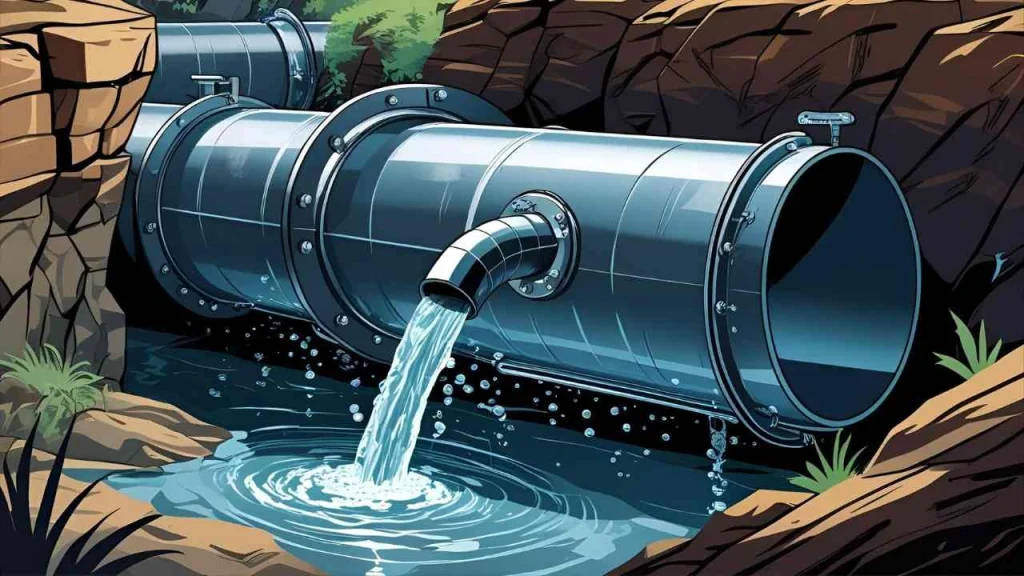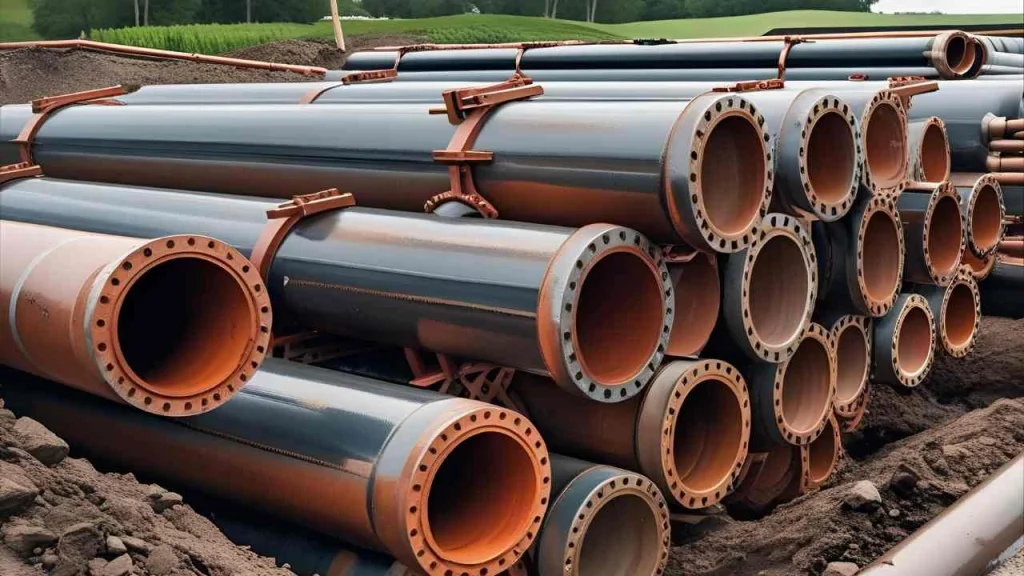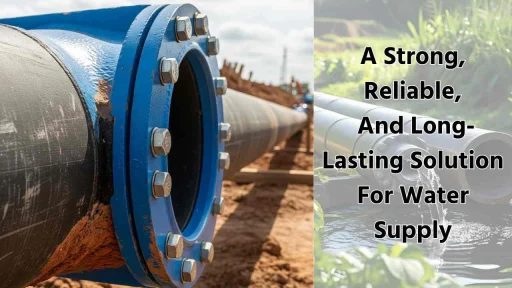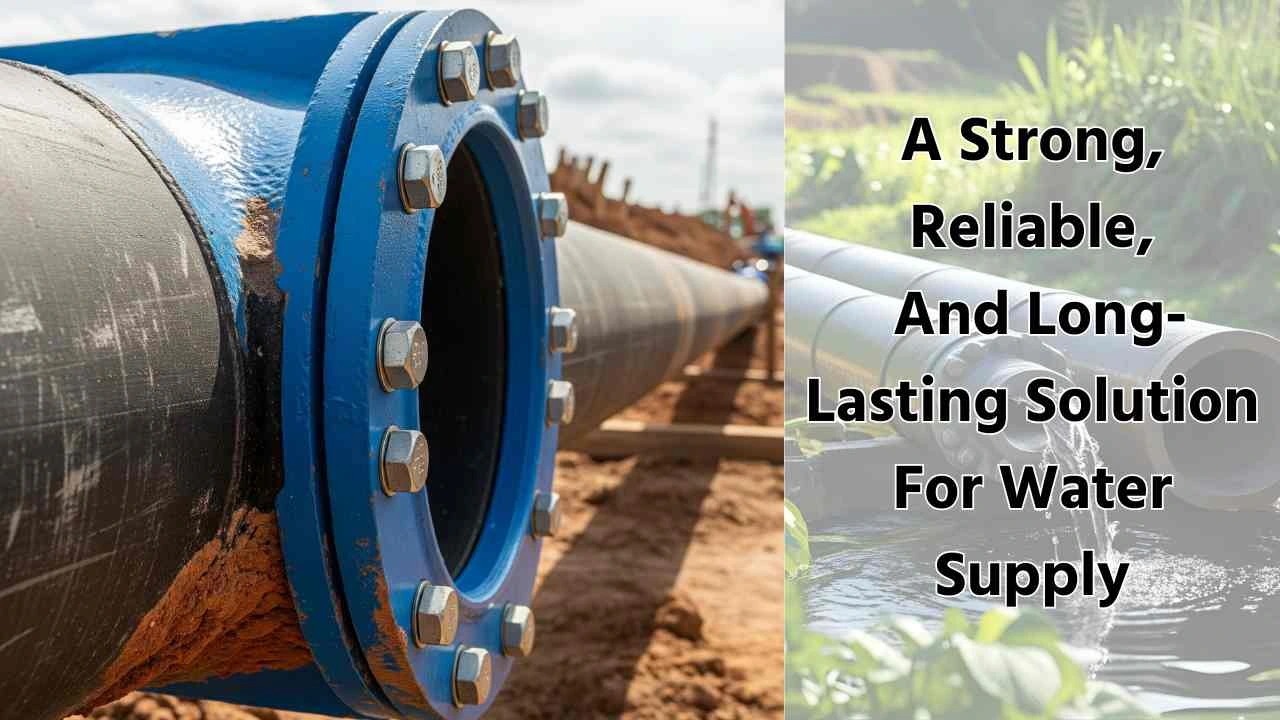The water supply and sewage system are vital to any modern city. The pipeline material used to deliver clean water or transport wastewater must be durable and safe. Ductile Iron Pipe (DIP), is a key component in this process. Their strength, flexibility and corrosion resistance help it. They have replaced older cast iron systems, and have become a trusted material in the water industry.
This article will explain what ductile Iron Pipe is, its making process, its utilization, and its main features. We will also discuss its applications, installation, maintenance, and benefits. We’ll also answer some common questions about ductile iron pipe. Let’s find out.
What Is A Ductile Iron Pipe

Ductile pipe refers to a cast iron pipe which has been made more flexible and durable by being treated. While cast iron is traditionally hard and brittle, the ductile variety bends rather than breaks under pressure. Its flexibility is what gives it its name.
They are used for water and wastewater systems as they can withstand high pressures and require minimal maintenance. The manufacturers add magnesium to the molten metal, which alters the structure and makes the material stronger and elastic.
Read More: Step-by-Step Process to Start an Profitable Education Franchise Business
How To Make Ductile Iron Pipe
They start by melting down scrap iron and steel in a blazing hot furnace. Once that stuff’s all liquefied, somebody throws in some magnesium to make the metal more flexible—because nobody wants a pipe that snaps under pressure. Next, they pour the molten metal into a spinning mold, so it takes shape as a pipe while cooling off.
Once the pipe’s solid, workers heat treat it to toughen it up. Quality check comes next—each pipe gets inspected to make sure it’s up to standard. After passing the test, they slap on a corrosion-resistant coating and line the inside with cement mortar. That way, the pipe can handle water without rusting out or messing up the water quality. Bam, there you have it: a strong, long-lasting ductile pipe.
Ductile Iron Pipe: Key Features
There are several characteristics that set Ductile Iron Pipes apart.
- High strength: These tubes can handle high pressures without cracking.
- Flexibility Ductile Iron bends instead of breaking, reducing the risk of pipe ruptures during ground shifting.
- Resistance to Corrosion: Coatings provide protection against rust, soil and other damage.
- Longevity They can last up to 100 years depending on the soil conditions.
- Installation is easy: In spite of their strength, the splicing and joining on site are simple.
Read Our Book For Your Better Business Growth
Ductile iron pipes: Advantages
Consider the benefits of using ductile steel pipes for infrastructure projects.
- Long Service life: In ideal conditions, ductile iron pipes will last over a hundred years.
- Strong, Reliable: They can handle high pressures from both the inside and outside.
- Safe Drinking Water: A cement-lined inner lining keeps the water clean and safe by preventing metal leakage.
- Eco Friendly Material: The ductile iron, which is 100% recyclable and made of recycled materials, is environmentally friendly.
- Lower maintenance costs: These pipes are more durable and require less repairs over time.
- Earthquake Resistant: Their flexible nature allows them to survive better ground movements than rigid pipes such as concrete or PVC.
Want To Know About Which Business Idea Would Be Better For You?
Go Through Our Startup Selector Tool
Common Applications Of Ductile Iron Pipes
Many industries use ductile iron tubes. Here are a few typical applications.
- Municipal Water Systems: The majority of city water mains consist of ductile iron pipe.
- Wastewater System: They effectively transport sewage and stormwater.
- Irrigation projects: These pipes transport water from agricultural areas to the fields.
- Use in Industry: In factories, they transport water, chemicals and other fluids.
- Firefighting System: Due high pressure resistance they are ideal for connection to fire hydrants.
Installation Of Ductile Iron Pipes
It is easy to install ductile iron pipe, but it needs care.
- Site preparation: Workers level the ground and dig trenches.
- Laying Pipes: First, you lay the pipes—line them up right in the trench.
- Joining pipes: Then, you join the pipes together, usually with mechanical or push-on joints. Gaskets go in too, so you don’t end up with a surprise water feature in your yard.
- Backfilling: After that, you backfill. Basically, you chuck the soil back on top and pack it down tight, so the pipes stay put.
- Testing: Finally, you test the whole setup. Turn the water on, check for leaks, and hope everything stays dry. If it does, boom—you nailed it.
Read More: Goa’s New Revolution: The Rise of a Manufacturing Business Hub
Maintenance For Ductile Iron Pipes

Regular inspections are important to avoid problems, even though ductile pipes require little maintenance.
- Check For Leaks: A drop in pressure could indicate a leak.
- Check the condition of joints: Joints may loosen with time. Periodic checks are important.
- Replace Gaskets As Needed: Worn out rubber seals can cause leaks. Replace Them.
Preventive maintenance extends the lifespan of the pipeline system as well as reducing the need for emergency repairs.
Ductile Iron Pipe Comparison vs. Other Materials
| Features | Ductile Iron Pipe | PVC Pipe | Concrete Pipe |
|---|---|---|---|
| Strengthening Your Body | Very High | Moderate | High-quality |
| Flexibility | High-quality | Very High | Low-cost |
| Durability | 50-100 Years | 25-50 Years | 50+ Years |
| Cost | Moderate | Low-cost | High-quality |
| Corrosion resistance | High (with Coating) | Very High | Moderate |
| Installation | Easy to Use | Very Easy | Difficult |
Read Our Project Report For Your Better Business
Conclusion – A trusted pipe for generations
Conclusion: ductile pipe is an excellent and durable option for water infrastructure. It combines iron’s strength with the flexibility and modern engineering. It is widely used by farmers, cities and industries because of its durability, reliability and eco-friendliness. The demand for cost-effective, durable, and strong solutions such as ductile pipe will increase in the future, as water systems grow.
The right piping can make a big difference to the water quality, system longevity, and savings over time. You get a solution built to last with ductile pipe.
Ductile Iron Pipes FAQs
Q1 : Is drinking water from ductile iron pipes safe?
It is. The interior is lined with cement, which keeps the water safe and clean.
Q2 : How long do ductile pipes last?
In general, ductile pipe lifespans range from 50 to 100 year, depending on the soil type, installation and maintenance.
Q3 : Can ductile pipes rust?
Although the iron itself is prone to rusting, these pipes are coated with zinc, bitumen or polyethylene to prevent corrosion.
Q4 : Are ductile pipes expensive?
Yes, they are more expensive than concrete pipes or stainless steel. They are low-maintenance and save money in the long term.
Q5 : Can these pipes recycled?
DUCTILE IRON IS 100% RECYCLABLE. It is therefore an environmentally-friendly option.
Q6 : What are the sizes of ductile iron pipe?
The pipes range from 3 inches up to 64 inches, and can be used for many purposes.
Q7 : Where are ductile pipes used most often?
Generally, they are used for city water systems, industrial water transport, and fire protection lines.
Q8. Are they easy for workers to repair?
They can be repaired by replacing damaged sections and resealing joints. They are often repaired without having to dig up large areas.






